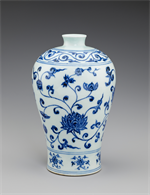Assets Conference 2025 Highlight: A Curator-Led Tour of Chinese Ceramics at the Smithsonian National Museum of Asian Art
Popular Tags

Wednesday, March 26, 2025 in News, Education, Conference
The ISA Assets Conference 2025 in Washington, DC is only one week away! AFDA Chair and Asian art specialist Ashley Crawford (MA, ISA AM) is here to tell us about the Chinese ceramics tour during our upcoming trip to the Smithsonian National Museum of Asian Art, which will be a highlight from the AFDA Tour #2.
On Thursday, April 3rd, after visiting the DAR Museum in the morning, we have an exciting private tour of the Smithsonian National Museum of Art’s Chinese ceramics collection planned, which will be led by Dr. Jan Stuart, the Melvin R. Seiden Curator of Chinese Art. The Smithsonian is home to one of the most impressive collections of Chinese ceramics in North America, so ISA is very fortunate to have the opportunity to view a wide range of world-class Imperial ceramics in person! We are also in for a treat to be able to learn from Dr. Stuart, who has worked with Chinese porcelain collections at the Smithsonian, Metropolitan Museum of Art, and British Museum, where she was the Asian art department head from 2006-2014 and facilitated the new gallery for the Sir Percival David collection of Chinese ceramics. There are three key objects from the Smithsonian’s collection that will be the focus of our tour: a guan ware vase, a Yongle meiping vase, and a Xuande copper red dish.

The first object is a 12th-century (Southern Song) stoneware guan vase. Unlike porcelain objects, stonewares are fired at lower temperatures. Guan wares are known for their light blue glaze with crackles and are related to the crackled ru and ge wares. Guan wares were among the first where the crackle was an intentional artistic decision rather than a firing error. Crackles have since become a popular ceramic design globally. Given that Song guan wares are nearly a thousand years old, it is rare to find examples of such high craftsmanship in this stellar condition!

The second highlight object is a Yongle (1403-1424) blue-and-white meiping vase. The Ming Dynasty (1368-1644) saw technological improvements that allowed for delicately crafted (but more durable) porcelain and intricate blue-and-white designs. The meiping (“plum vase”) shape is one of the most popular in Chinese ceramics, with origins dating to the Tang Dynasty (618-907). Shortly after the Yongle period, the third highlight object was created, during the Xuande period (1426-1435). Both reigns produced some of the most unique and valuable porcelain from the Ming Dynasty. Xuande copper red monochromes were used as altar vessels and surviving examples from this period are rare. While monochromes were also very popular during the Qing Dynasty (1644-1912), the Xuande technology was lost and has still not been replicated, meaning that this dish marks a special moment in history.

Additionally, The Smithsonian National Musuem of Art is famous for its well-traveled Peacock Room, which originated in London and has since traveled to Detroit and Washington DC. Today, this gilded green space celebrates the museum’s antique Chinese blue-and-white porcelain collection, but the room also has an intricate history. The project began as a dining room renovation by Thomas Jeckyll in the 1870s in London, before being redesigned by James McNeill Whistler and eventually relocated to its current location in Washington DC. Whistler’s process was fraught with conflict, during which he painted a gold mural of fighting peacocks, titled Art and Money; or, The Story of the Room. This demonstrated Whistler’s dissatisfaction with the British patron Frederick Leyland, who had refused to pay him. The scandal continued for years, as is reflected Whistler’s subsequent book The Gentle Art of Making Enemies. You can read more about the dramatic history of the room here.
The AFDA Committee is looking forward to seeing you all next week at the ISA Assets Conference 2025! You can register for the AFDA Tour #2 here.

Ashley Crawford (MA, ISA AM) is the founder of the appraisal firm Ashley Asian Art and is an experienced Asian art specialist and provenance researcher. Her specialties include Buddhist antiques, ceramics, Indian miniature paintings, and musical instruments. Originally from San Francisco, she now spends her time between the US and London.
Ashley holds two degrees in Asian art history from the School of Oriental and African Studies, University of London, both with high distinction. Previously, she earned degrees in musicology at Scripps College and Christ Church, University of Oxford.
She is the current chair of ISA’s Antiques, Furnishings, and Decorative Arts Committee (AFDA) and serves on the Conference Committee.
Image Descriptions and Sources:
1. Image 1: A guan ware vase (light blue with a crackle glaze) against a white background. Source: https://asia.si.edu/explore-art-culture/collections/search/edanmdm:fsg_F1911.338/
2. Image 2: A floral blue-and-white meiping vase from the Yongle period against a gray background. Source: https://asia.si.edu/explore-art-culture/collections/search/edanmdm:fsg_F1952.5a-b/
3. Image 3: A copper red monochrome dish from the Xuande period against a light gray background. Source: https://asia.si.edu/explore-art-culture/collections/search/edanmdm:fsg_F2015.2a-b/
4. Image 4: Picture of Ashley Crawford standing before a Vietnamese Quan Am statue against a blue background.
Other Relevant Links:
1. The Smithsonian National Museum of Asian Art’s website: https://asia.si.edu/
2. Dr. Jan Stuart’s bio: https://asia-archive.si.edu/about/contact/staff/jan-stuart/
3. Making the Peacock Room: https://asia.si.edu/explore-art-culture/interactives/peacock-room/making-the-peacock-room/
4. ISA Assets 2025 Conference Registration: https://www.isa-appraisers.org/annual-conference
5. Ashley Asian Art: https://www.ashleyasianart.com
